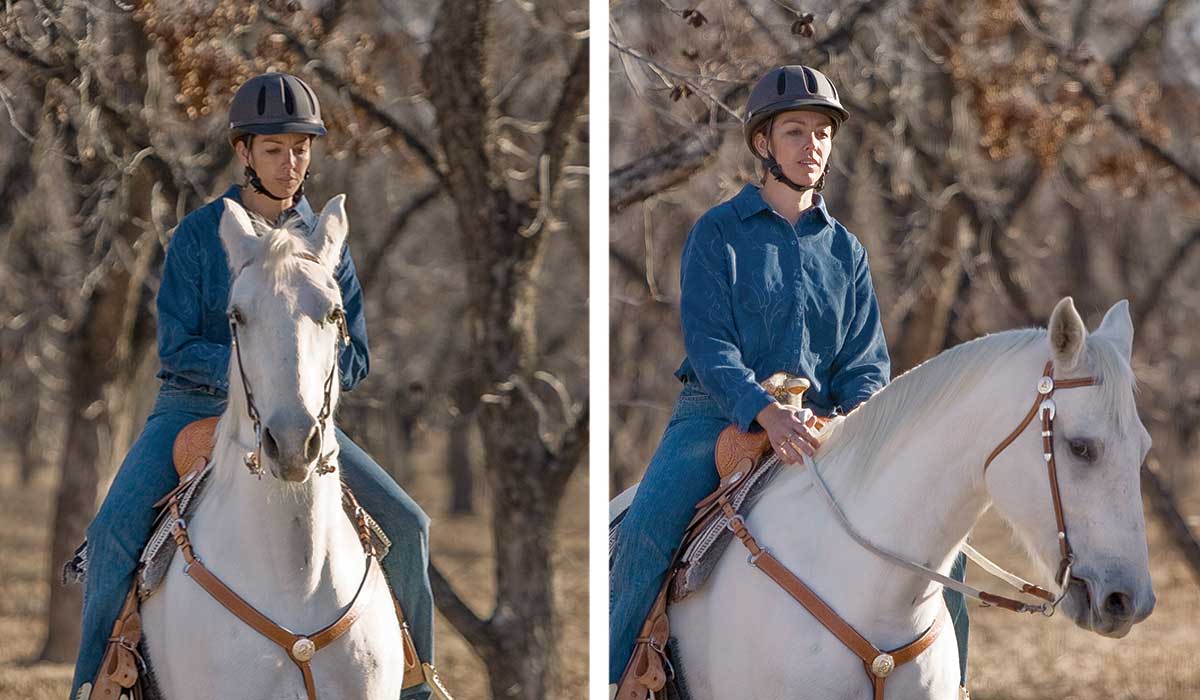
Riding out alone—just you and your horse—can be a relaxing venture. But if your horse thinks he should be back at the barn with his equine friends, your ride might be anything but peaceful.
[READ: Turn Back for Safety]
Horses are hardwired to be in a herd. In the wild, the herd meant security, safety, and survival. This instinct can lead your horse to become herd-bound (refusing to leave his herdmates—those at home or on the trail) or barn-sour (turning toward home on his own). By using clear leadership and direction, you can teach him to overcome this undesirable behavior and willingly walk the path you choose.
Here, I’ll teach you how to be your horse’s leader and to make corrections when your horse even thinks about veering from your chosen path. When you immediately keep him on course, he’ll know you’re in charge. I’ll also provide a strategy to calm your horse if he throws a fit, so you can enjoy a peaceful ride.
Be the Leader
When you mount up and head down your selected trail, you must be your horse’s leader in your herd of two. A strong trail leader knows the route, is confident, and will enforce rules with fairness. The rules for a trail ride are simple: Travel at the speed and in the direction the leader chooses.
To cue your horse to move forward, relax your arms, move your rein hands in front of the saddle horn, and cue with gentle leg pressure. (Anytime you move your hands behind the saddle horn, you tell your horse to stop his forward motion.)
Assume the leadership role. Look in the direction of your chosen path. Point your whole body—your hips, core, and shoulders—in the direction you want to go, so you clearly communicate your intention to your horse.
If you’re nervous about riding out alone, pay attention to your body position and cues. When you’re stressed, it’s easy to collapse your shoulders and pull back on the reins. These fearful moves not only cue your horse to stop, but also give him a reason to question your leadership. Instead, breathe deeply, keep your shoulders back and down, and allow slack in the reins.
[READ: Julie Goodnight’s Tips to Take Charge]

Correct Infractions
If your horse even glances back toward the trailer, your home barn, or his trail buddies, use your reins to point him back toward your chosen path. For example, if he looks to the right, bump your left rein to move his nose back toward your path. By immediately correcting his quick glances and head turns, you can stop him from escalating his herd-bound or barn-sour behavior.
Always turn away from the direction in which your horse wants to go. For example, if he begins to turn to the right to choose his own path, turn him to the left. If he starts to turn to the right and you continue to turn him in that direction (that is, circling him to get to the place you want to go), he’ll think he got his way and the undesirable behavior will escalate. You must always turn away from the direction in which he wants to go to show him that you’re the herd leader and that you choose the path.
Stop the Balk
If your horse balks (refuses to move forward), allow slack in the reins by reaching your rein hands toward his ears. The slightest tension in the reins will give your horse the excuse he’s looking for to stop or to turn back.
Use escalating leg aids against his side to prompt your horse forward. Start with light leg pressure, and continue to escalate the pressure until he steps forward. When he does take a step forward, stop your leg cues as a reward.
If your horse begins to throw a fit (threatens to rear or moves in the opposite direction from where you cued him to go), ask him to work instead of focusing on returning to the trailer or barn. Ask him to turn to the left, then to the right, then back to the left. On safe footing, ask him to trot. After a minute or two, ask him to walk the path again.
Keep in mind the classic tenet of horse training: Make the right thing easy and the wrong thing hard.
Once your horse is focused on you and willingly walks the path you dictate, calmly ride forward. Keep your reins down in front of the saddle horn and your legs relaxed but held closely to his sides.
When you pick the route—and know what to do if your horse decides he should be in charge—you’ll be a strong leader who can ride your equine friend peacefully and independently down any trail.
Trainer and clinician Julie Goodnight, Poncha Springs, Colorado, hosts RFD-TV’s, Horse Master. Learn more about Julie’s program and training methods at juliegoodnight.com.






